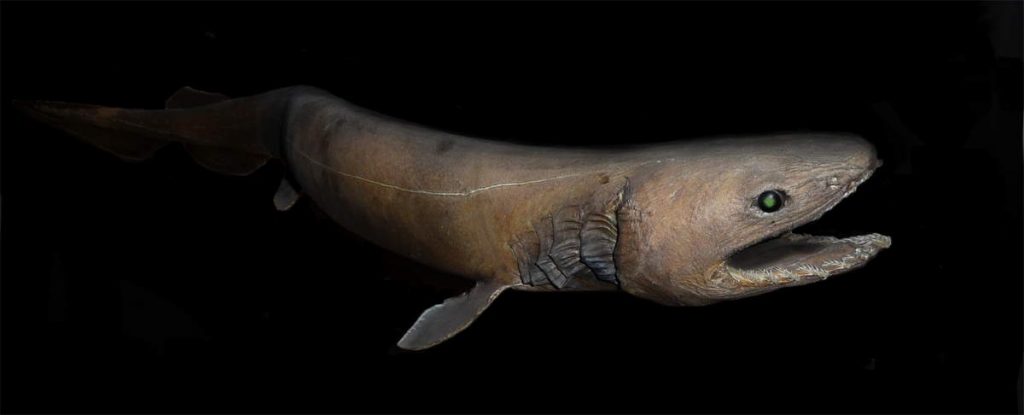The sperm whale, also known as the cachalot (scientific name: Physeter macrocephalus) is the largest of the toothed whales in the world’s oceans. Here are 20 amazing sperm whale facts.
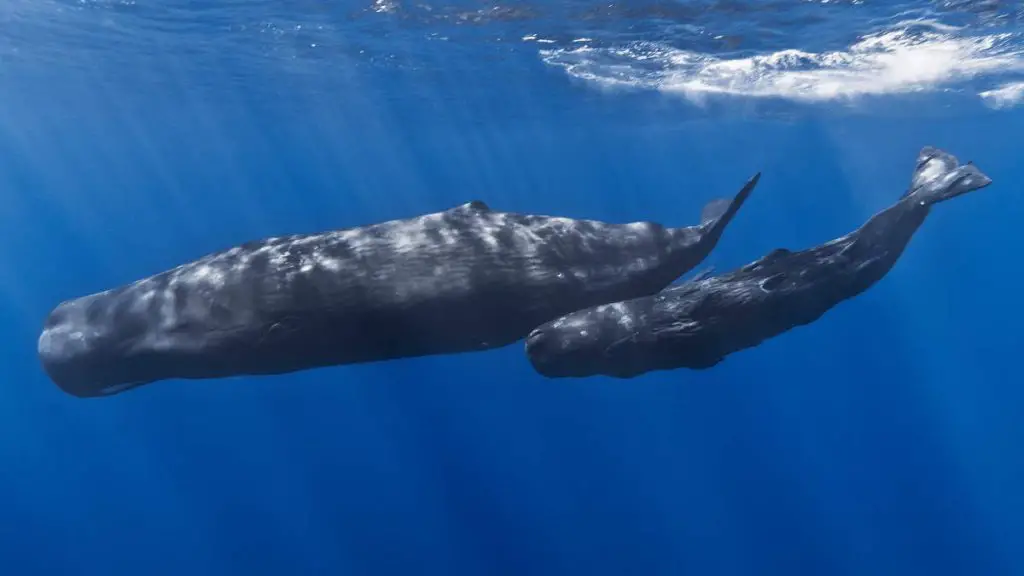
Sperm Whale Facts
1. Sperm whale is the biggest toothed predator on earth
Mature males average 16 meters (52 feet) in length but some may grow up to 20.7 meters (68 feet). Males can weigh up to 80 tonnes (79 long tons; 88 short tons).
Females are much smaller, though, males are typically 30% to 50% longer and three times as massive as females. The average length of a female is 12 meters (40 feet).
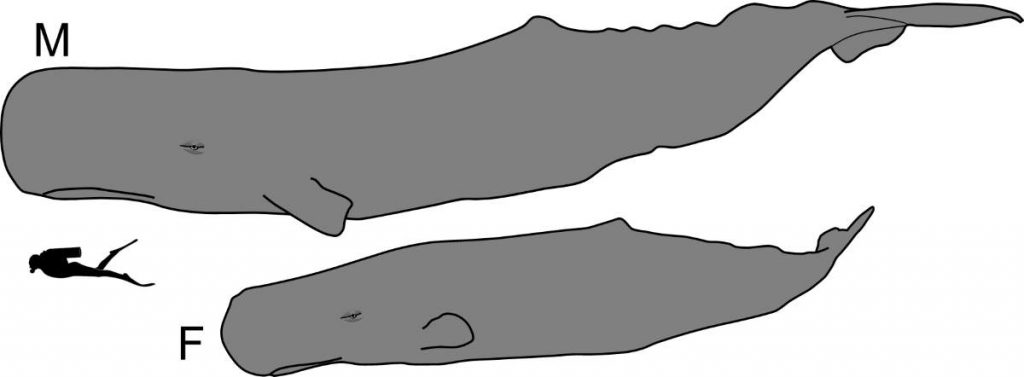
2. They have the biggest brain in all animals
Weighing on average about 7.8 kilograms (17 lb) and with a volume of about 8,000 cm3, the brain of the sperm whale is the largest known of any modern or extinct animal. This is more than three times of an average adult human’s brain.
Their relative brain size (EQ) is small, though (only about 0.3), compared to other mammals like humans (7.4), dolphins (5.3), dogs (1.2), cats (1.0), horses (0.9), and rats (0.4).
3. Sperm whale is the third deepest diving mammal
After the southern elephant seal and Cuvier’s beaked whale (the deepest diving mammal), the sperm whale is the world’s third deepest diving mammal. They can dive up to 2,250 meters (7,382 feet).
4. They can hold their breath for up to 2 hours
That’s one of the reasons that they can dive really deep.
5. They are loud!
The loudest animal on Earth, the sperm whale uses echolocation and vocalization as loud as 230 decibels (re 1 µPa m) underwater – this is more than an airplane jet engine at takeoff.
It is even hypothesized that they can stun or even kill their prey using sounds.
The loudest recorded sound produced by a sperm whale was a single click that reached 235 decibels above the water surface! That’s the sound pressure that a Saturn V moon rocket creates at a distance of only 1 meter (3 feet)!
Sperm whales primarily hunt in the twilight zone of the ocean (200 to 1,000 meters – about 650 to 3,300 feet below the ocean surface, just beyond the reach of sunlight). Thus, these animals rely on echolocation to locate their prey. By omitting these high-pitched clicks and listening to the echoes as they bounce off of objects, they are able to locate their prey within the dark oceans. A perfect natural sonar!
6. Each sperm whale has its own distinctive “coda”
Speaking of their sound… they also produce complex patterns of clicks called “codas”. Each whale has its own distinctive “coda”. Scientists think that this is how they recognize one individual from another.
7. They get their name from a misunderstanding of their anatomy
The sperm whale’s common name originated at the end of the 18th century through the 19th century – the heyday of the commercial whaling industry. Their big head (their alternative name, “cachalot”, which was given by the early whalers, means “big head”, comes from the Spanish and Portugues) contains an enormous fluid-filled organ (which whalers called the case).
During whale harvests, this organ, now called the spermaceti organ, was discovered to contain a white liquid that whalers mistook for the sperm of the whale.
The spermaceti organ has a volume as large as 2,000 liters (530 gallons) and can extend through 40 percent of the whale’s length.
Spermaceti organ’s surrounding wall, known as the case, is extremely tough and fibrous.
Since the whales being so difficult to study, the Spermaceti organ’s role is unknown, but there are some suggestions why it exists, including echolocation ( focus and control the beam of sound that the whale uses for echolocation), a diving/buoyancy aid (see notes 1), and as a battering ram/shock absorber.
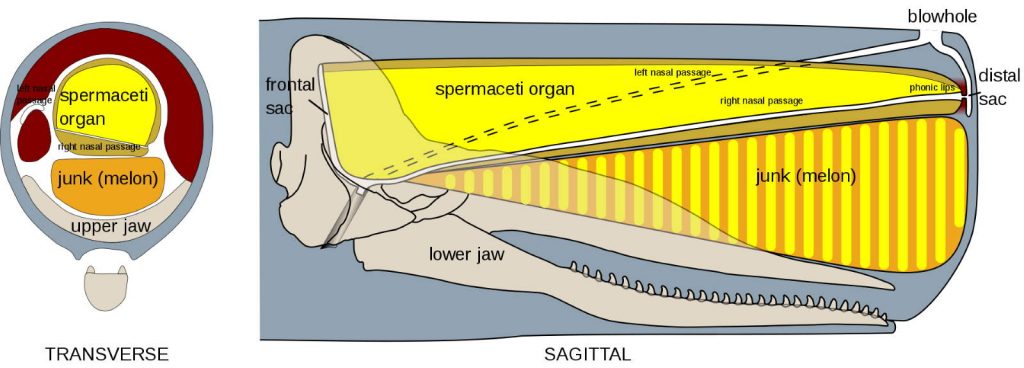
The whalers hunted sperm whales for the oil filling the spermaceti organ – it was used in a variety of commercial products such as lamp oils, soaps, and cosmetics. The ambergris, a solid, waxy, flammable substance of a dull grey or blackish color produced in the digestive system of sperm whales was also highly valued by perfumers as a fixative that allows the scent to endure much longer (see the bonus fact below). Today, fortunately, it has been mostly replaced by synthetic ambroxide (widely known by the brand name Ambroxan).
8. Their head is the biggest on earth
Their heads comprise up to 35% of their entire body length. The biggest head in all animals.
9. They attacked and sunk ships in history
In history, sperm whales attacked and some whaler ships. The most well-documented instances are American whaler ships Essex (sunk in 1820) and Ann Alexander (sunk in 1851).
Essex was thousands of kilometers away from the nearest shore when it sunk. Survivors used the ship’s remaining whaleboats to reach the land. But they heavily suffered from hunger and dehydration, and eventually resorted to cannibalism (eating the bodies of the crewmen who had died).
Only 8 survivors were rescued from the 20-man crew.
Essex’s story inspired the American writer Herman Melville (1819-1891) to write his famous 1851 novel Moby-Dick.
10. Melville’s Moby Dick partially inspired by a real sperm whale called Mocha Dick
Moby Dick, the sperm whale in Herman Melville’s famous 1851 novel with the same name, is also partially inspired by a real sperm whale called Mocha Dick of that period. Melville’s Moby Dick is an albino like Mocha Dick.
Mocha Dick survived many skirmishes with the whalers but was eventually killed in 1838. His unusual appearance and ability to survive many attacks quickly made him famous.
11. They have large teeth
Sperm whale’s cone-shaped teeth are really large. They are between 10-20 cm (3.94-7.88 inches) in length and weigh up to 1 kilogram (2.2 lb) each.
The teeth (18 to 26 on each side of the lower jaw) fit into sockets in the upper jaw (see the photo below).
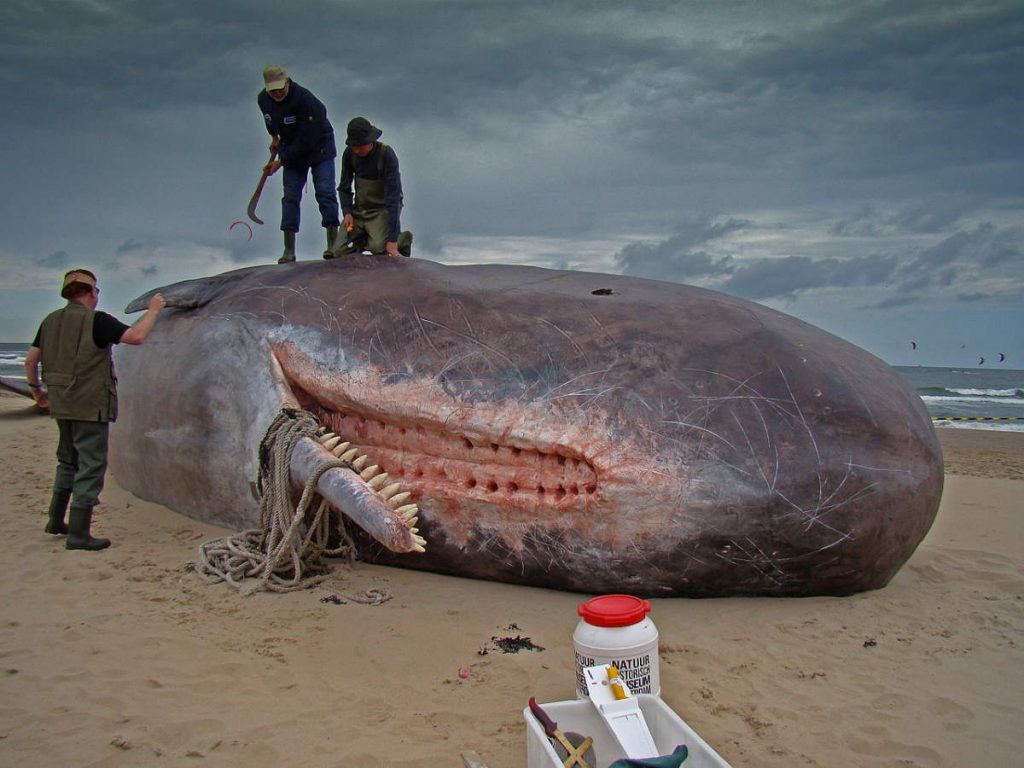
Analyzing the teeth is the preferred method for determining an individual’s age. Their teeth build distinct layers of cementum and dentine as they grow, just like the age-rings in a tree.
12. They have a very characteristic blow
It is directed forwards and to the left and it projects about 5 meters (16 feet). A sperm whale can be easily identified by this characteristic of the blow, even at some considerable distance, especially if it’s not a windy day.
13. They are constantly feeding
The sperm whales eat continuously. They can eat about 3% of their body weight daily, up to 2 tons of food sometimes!
14. Their total consumption of seafood is less than that of humans
Despite their huge appetite and size, the total annual food consumption by sperm whales worldwide is estimated to be about 91 million tonnes for about 300,000-450,000 individuals. In comparison, human consumption of seafood is estimated to be 115 million tonnes for more than 7.8 billion individuals.
15. Their prey include one of the biggest fish in the world: the megamouth shark
Sperm whales feed on several species like the giant squid, colossal squid, octopuses, and fish. But, scientists also think that they also prey on the megamouth shark, one of the biggest fish species in the world’s oceans.
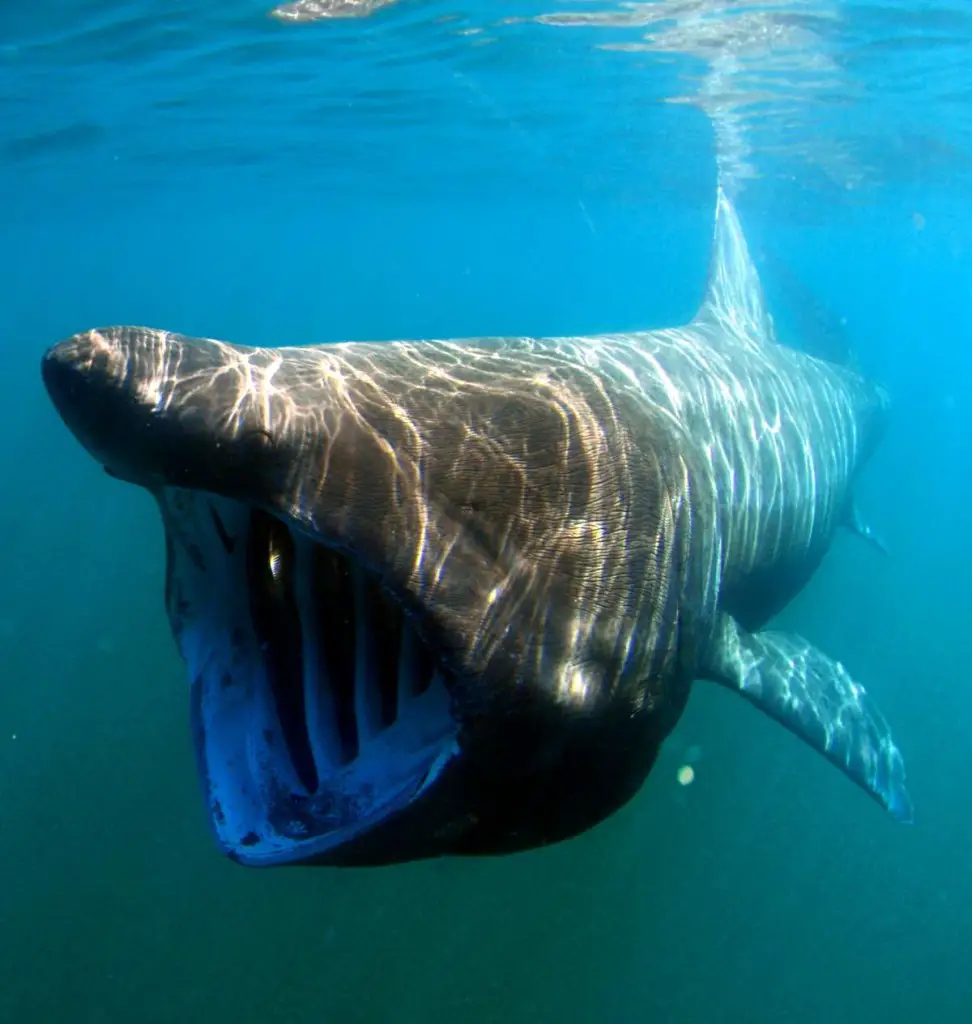
Related: Largest fish species
16. All living sperm whales seem to have all descended from a single female
According to a study published in the journal Molecular Ecology, every living sperm whale is a descendant of a single grandmother that lived around 80,000 years ago.
Researchers examined 1,600 individuals around the world and all these whales contained similar mitochondrial DNA (genes passed on from mother to child) – from the same 80,000-year-old female ancestor.
17. They are social
They are very social animals. They live in pods of up to 20 individuals. The larger pods allow the females to better protect their babies against predators like orcas or great white sharks.
18. They have a big sexual dimorphism
Compared to other whales, sperm whales have a bigger sexual dimorphism (different characteristics i.e. size, behavior, etc. in males and females of the same species).
19. They don’t sleep much – and they sleep vertically!
Surprisingly for such large predators, sperm whales sleep for short periods and don’t spend much time sleeping. They tend to only nap for 15-20 minutes and in total, their nap time only accounts for 7% of the day (about 1.5 hours) which makes them the least sleep-dependant mammals.
They sleep in a vertical position with their heads just below or at the surface. This unusual sleep was first seen in 2008. During these short naps, each individual floated motionless for 15-20 minutes.
And they even didn’t breathe during the naps!
20. They live long
They can live 70 years or more. Females become fertile at around 9 years of age. The oldest pregnant female ever recorded was 41 years old.
Lactation proceeds for 19 to 42 months, but though rarely, calves may suckle up to 13 years!
Bonus fact: sperm whale poop worth more than gold!
The giant squid (Architeuthis dux) and the colossal squid (Mesonychoteuthis hamiltoni) and other squid species make up to 80 percent of sperm whale’s diet.
The indigestible parts of these animals (i.e. beaks, pens, and eyelids) begin to accumulate over time in the whale’s digestive system. Normally, the whale can either vomit or defecate these indigestible parts.
In rare cases, however, these parts along with parasitic worms, fecal matter, and protective wax of the digestive system of the whale clump together. This clump grows bigger over time, and finally, it gets defecated out, or unfortunately for the whale, ruptures the colon, and kills the animal.
Once the clump is released from the sperm whale’s body, it floats at the surface of the ocean for years. Sunlight, saltwater, bacteria, and enzymes within the mass purify the clump with some chemical processes. Finally, the clump becomes ambergris, which has a sweet scent.
As explained above, the ambergris is highly valued by perfumers as a fixative that allows the scent to endure much longer. It even worths more than gold!
Sperm Whale conversation status
Sperm whales are listed as vulnerable by the International Union for Conservation of Nature and as endangered on the United States Endangered Species Act.
Today, the greatest threats to the sperm whale population are entanglement in fishing nets and collisions with ships. Marine debris, ocean noise, and chemical pollution also threaten them.
They are slowly recovering from centuries of commercial whaling. The current population of sperm whales is estimated at a few hundred thousand individuals. Whaling also contributed the global warming greatly by reducing the number of sperm whales. It is estimated that whaling has resulted in an extra 2 million tonnes of carbon remaining in the atmosphere each year.
Notes
- The waxy oil within the organ has a melting point of 32 degrees Celsius. By controlling blood flow to the organ (and therefore its temperature), the whale might be able to control whether the wax is liquid or solid. If the wax is solid, it contracts and becomes denser, making the whale sink better. When melted again, the wax expands, making the whale less dense and more buoyant. This could be a way of helping the whale to control dives and ascents. Source
Sources
- Sperm Whale on Wikipedia
- How Did the Sperm Whale Get Its Name? on the Britannica website
- Mocha Dick on Wikipedia
- “Could a Whale Accidentally Swallow You? It Is Possible” on the Smithsonian Magazine website
- “Mocha Dick: The Real-Life Whale That Gave Moby Dick His Name” on the Smithsonian Magazine website
- “7 Facts About Sperm Whales” on the National Wildlife Federation blog
- “Sperm Whale – Physeter macrocephalus” on the Cool Antarctica website
- Sperm Whale on the Oceana website
- Sperm Whale on the NOAA Fisheries website
- “Every Sperm Whale Alive Today May Have Descended From the Same Female” on the Smithsonian Magazine website
- Video by Hashem Al-Ghaili: “Sperm Whales have the biggest mammalian brain on Earth” on Facebook
- Budget of NASA, Year by Year [1980-1989] - June 10, 2024
- Budget of NASA, Year by Year [1970-1979] - June 10, 2024
- Budget of NASA, Year by Year [1958-2024] - June 10, 2024

